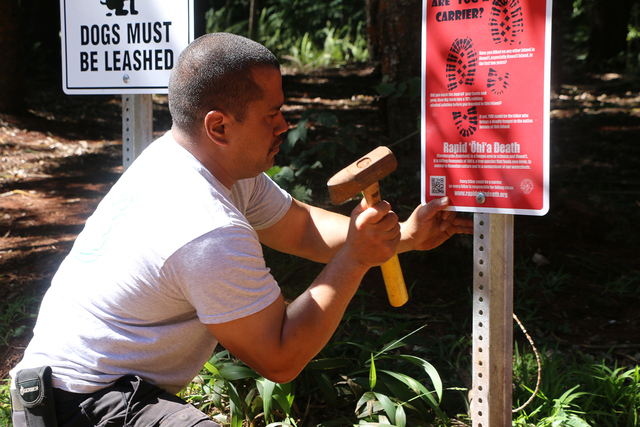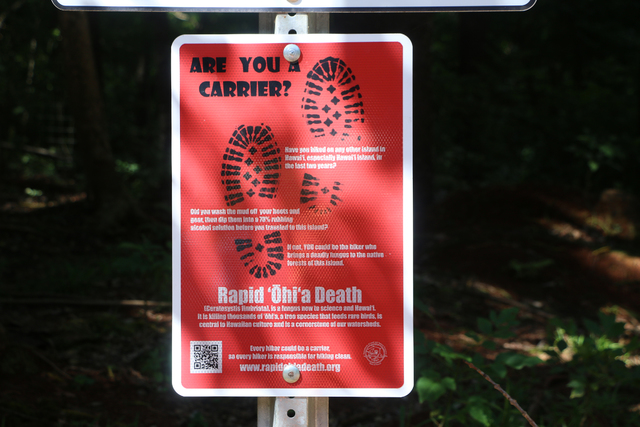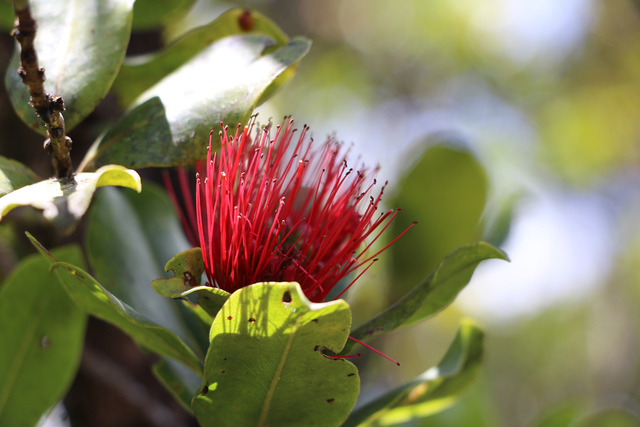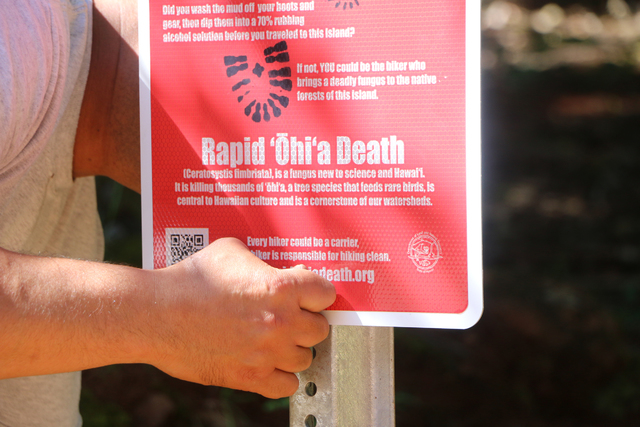Signs are in the process of being posted at state trailheads on the Big Island and Maui amid the fight to stop the spread of rapid ohia death, the fungal disease that has decimated thousands of acres of native ohia
Signs are in the process of being posted at state trailheads on the Big Island and Maui amid the fight to stop the spread of rapid ohia death, the fungal disease that has decimated thousands of acres of native ohia on the Big Island.
Dozens of scientists, foresters, surveyors, researchers, and educators from federal, state, county and nonprofit organizations are actively involved the effort, however, education and outreach are also key to stopping the disease in its tracks.
Anya Tagawa, with DLNR Division of Forestry and Wildlife’s Natural Area Reserve Hawaii Island program, and Jeff Bagshaw, of the NAR’s Maui Island program, are two of the soldiers on the frontline of spreading awareness about rapid ohia death. They’ve each created signs that hunters, hikers, mountain bikers and other people recreating on state public lands will soon see.
The signs are different in appearance, but contain the same basic message. Rapid ohea death kills one of the most important native trees quickly and in wide swaths. Failing to follow the simple recommendations outlined on both signs could make people responsible for spreading this disease inter-island and intra-island.
“It is critical that every person who goes into the woods or forest anywhere in Hawaii, takes steps to prevent this disease from spreading. Anya and Jeff’s work along with a team of other outreach experts, is vitally important in getting kamaaina and visitors alike to be certain they don’t inadvertently track the fungus from place to place,” said Suzanne Case, DLNR chairwoman.
Tagawa’s passion follows a life spent in the forest. Having grown up hiking, exploring and being captivated by Hawaii’s forests, she feels an intimate connection to the special places.
“Rapid ohia death threatens this way of life. It is imperative that we do all what we can to ensure ohia is present for our future generations to experience, engage, and form a relationship with. It is critical for the continued persistence of the countless unique plants and animals that rely on ohia,” she said.
While the nearest wild ohia may be dozens of miles away, Bagshaw, outreach coordinator at the Ahihi-Kinau NAR on Maui’s south shore, designed the sign for the Na Ala Hele Trails Access system, because he is concerned about the fate of the forests.
“We hope hikers and all forest users will start to be conscious wherever they go, even if there’s ohia there or not. We’d like them to realize, that they could be taking something into the forest that affects our native ecosystems. Ohia are the backbone of our native rainforest; they feed the honeycreepers, they protect the watershed. I can’t imagine a Hawaiian rainforest without ohia,” he said.
Recently, Bagshaw, his staff, and volunteers conducted surveys with visitors to the Ahihi-Kinau NAR. They’ve found very few people had knowledge of ohia or the disease, however, they were willing to adopt the preventative measures outlined on each of the trail signs.
Tagawa’s signs will eventually be at more than 50 DOFAW trailheads on the Big Island. On Maui, Bagshaw’s signs are being placed at all Na Ala Hele trailheads.






